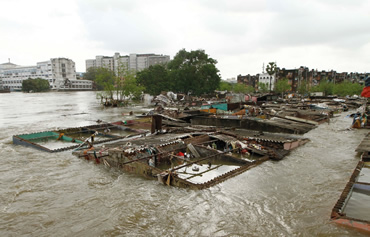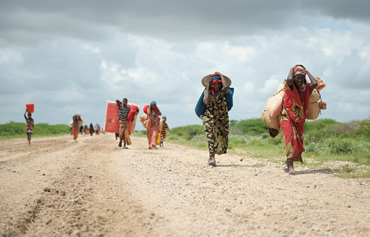Part 2 - Mapping hotspots
Flooding
Strong increase in potential flood risks
Flood risk increases mainly due to population growth and economic development.
Millions of people are living in flood-prone areas
x million people
Source: PBL
In 2010, around 1 billion people around the world were living in flood-prone areas, potentially exposed to either river or coastal flooding. This number is projected to increase to over 1.6 billion by 2050. Many more people are potentially exposed to river flooding than to coastal flooding.
River flooding
Share of the population annually exposed to river flooding increases, especially in Asia
Overall, more extreme precipitation will increase the risk of river flooding. Most of the people at risk of river flooding live in developing countries, especially in the South Asia and East Asia Pacific regions.
x 1000 persons
What causes the change in exposed population between 2010 and 2050?
Select a region or a country from the drop-down menu on the right.
Share of the population annually exposed to river flooding in South Asia
x 1000 persons
Source: Deltares, IVM
Coastal flooding
Share of the population annually exposed to coastal flooding, high scenario climate change (RCP 8.5)
This is due to population growth, sea level rise and land subsidence. Most of the people exposed to coastal flooding live in Asia, both in 2010 and 2050. Numbers are much lower than for river flooding.
x 1000 persons
What causes the change in exposed population between 2010 and 2050?
Select a region or a country from the drop-down menu on the right.
Share of the population annually exposed to coastal flooding in South Asia
x 1000 persons
Source: Deltares, IVM
Urbanisation changes flood vulnerability
By 2050, 70% of the world population is projected to live in an urban environment. The global urban area is expected to expand by more than 70%, for a large part in riparian and coastal areas, and in deltas.
Cities with millions of inhabitants will continue to grow between now and 2050
Population in cities in 2010 and 2050
Source: PBL
Fast urban growth, more than doubling city sizes, occurs especially in the developing countries of East and South Asia and Sub-Saharan Africa.
Risks for people are unequally distributed
Source: PBL
Risks for people are unequally distributed. While the developed countries will face most of the economic damage, the majority of people at risk live in developing countries. The number of people at risk will increase more for the developing than for the developed countries.
Informal settlements are the most exposed to flooding

Especially in developing countries, the inhabitants of informal settlements in cities make up more than 50% of the urban population.
Water- and climate-related disasters disproportionately affect people living in informal settlements.
Flood protection pays off
There are several ways to reduce flood risk. Investments in levees, dykes and storm surge barriers, as well as taking flood risk into account in spatial planning and building codes, will reduce both economic risk and the risk of large numbers of casualties.
Flood protection strongly reduces population exposed to river flooding

Source: Deltares, IVM
The figures about river flooding as published in ‘The Geography of Future Water Challenges’ (2018) are updated based on an improved version of the flood risk model GLOFRIS which includes:
- An improved version of the global hydrological model PCR-GLOB-WB with a higher resolution.
- An improved bias-correction method based on flood volumes.
- An improved version of the FLOPROS global database on flood protection.
- An improved dataset of the 2UP global urban development model, improving the exposure data (population and GDP).
Without any protection against flooding, about 252 million people would be exposed to river flooding, each year, based on current population numbers.
Actual protection levels, however, result in a substantial decrease in the number of people exposed, annually. An estimated 65 million people are exposed to flooding, each year, based on current levels of flood protection.
If current protection levels are maintained, the annual number of people exposed to flooding will more than double, by 2050.
If we adapt flood protection standards to climate change we can reduce this number to 108 million.
We can even reduce this number to less than 7.5 million by increasing the protection of cities to a flood probability standard of 1:100–1:1000.







